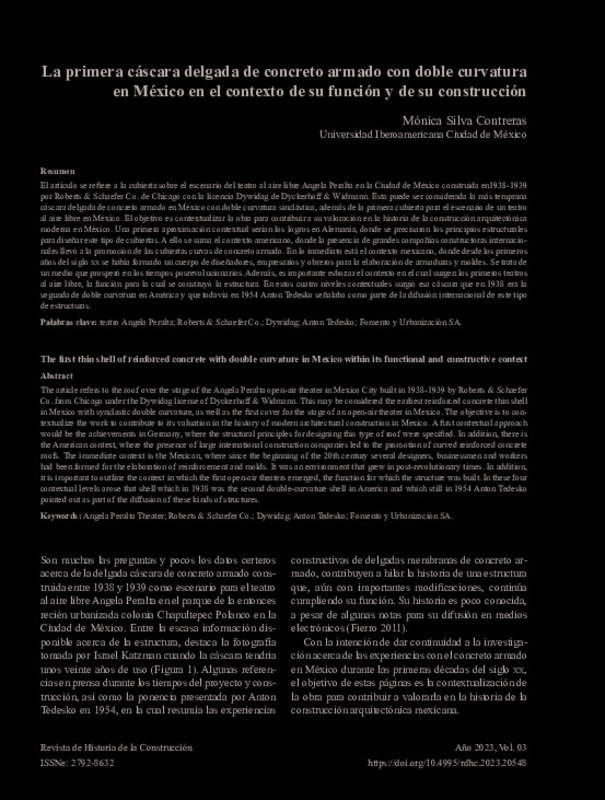|
Resumen:
|
[EN] The article refers to the roof over the stage of the Angela Peralta open-air theater in Mexico City built in 1938-1939 by Roberts & Schaefer Co. from Chicago under the Dywidag license of Dyckerhoff and Widmann. This ...[+]
[EN] The article refers to the roof over the stage of the Angela Peralta open-air theater in Mexico City built in 1938-1939 by Roberts & Schaefer Co. from Chicago under the Dywidag license of Dyckerhoff and Widmann. This may be considered the earliest reinforced concrete thin shell in Mexico with synclastic double curvature, as well as the first cover for the stage of an open-air theater in Mexico. The objective is to contextualize the work to contribute to its valuation in the history of modern architectural construction in Mexico. A first contextual approach would be the achievements in Germany, where the structural principles for designing this type of roof were specified. In addition, there is the American context, where the presence of large international construction companies led to the promotion of curved reinforced concrete roofs. The immediate context is the Mexican, where since the beginning of the 20th century several designers, businessmen and workers had been formed for the elaboration of reinforcement and molds. It was an environment that grew in post-revolutionary times. In addition, it is important to outline the context in which the first open-air theaters emerged, the function for which the structure was built. In these four contextual levels arose that shell which in 1938 was the second double-curvature shell in America and which still in 1954 Anton Tedesko pointed out as part of the diffusion of these kinds of structures.
[-]
[ES] El artículo se refiere a la cubierta sobre el escenario del teatro al aire libre Angela Peralta en la Ciudad de México construida en1938-1939 por Roberts & Schaefer Co. de Chicago con la licencia Dywidag de Dyckerhoff ...[+]
[ES] El artículo se refiere a la cubierta sobre el escenario del teatro al aire libre Angela Peralta en la Ciudad de México construida en1938-1939 por Roberts & Schaefer Co. de Chicago con la licencia Dywidag de Dyckerhoff y Widmann. Esta puede ser considerada la más temprana cáscara delgada de concreto armado en México con doble curvatura sinclástica, además de la primera cubierta para el escenario de un teatro al aire libre en México. El objetivo es contextualizar la obra para contribuir a su valoración en la historia de la construcción arquitectónica moderna en México. Una primera aproximación contextual serían los logros en Alemania, donde se precisaron los principios estructurales para diseñar este tipo de cubiertas. A ello se suma el contexto americano, donde la presencia de grandes compañías constructoras internacionales llevó a la promoción de las cubiertas curvas de concreto armado. En lo inmediato está el contexto mexicano, donde desde los primeros años del siglo xx se había formado un cuerpo de diseñadores, empresarios y obreros para la elaboración de armaduras y moldes. Se trata de un medio que prosperó en los tiempos posrevolucionarios. Además, es importante esbozar el contexto en el cual surgen los primeros teatros al aire libre, la función para la cual se construyó la estructura. En estos cuatro niveles contextuales surgió esa cáscara que en 1938 era la segunda de doble curvatura en América y que todavía en 1954 Anton Tedesko señalaba como parte de la difusión internacional de este tipo de estructuras.
[-]
|









